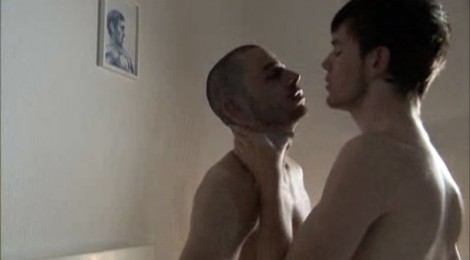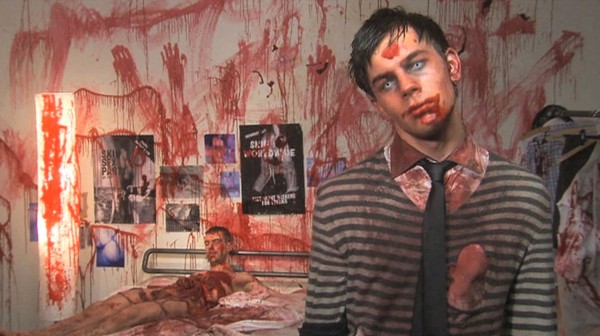
Against Any Consensual Reality: A Revaluing of Bruce LaBruce’s Otto; or, Up with Dead People
By Christopher Higgs
Christopher Higgs writes criticism and experimental prose from the swampy jungle of Tallahassee, Florida, while completing his doctoral dissertation at Florida State University, where he teaches literature and writing. He has published two books of fiction, and many shorter works in various journals and magazines. A regular contributor to the popular literary website HTMLGIANT, he also curates the critically acclaimed online art gallery Bright Stupid Confetti. You can learn more by visiting his website.
As the double title of Bruce LaBruce’s controversial 2008 film suggests, Otto; or, Up with Dead People resists simplicity and containment. In nearly every way, it overflows. Narrative frames nestle within but continually spill over into other narrative frames. Performances perform other performances. Metaphors pile on metaphors, mixing and convoluting in sometimes sour and sometimes glittering ways. Genres blend and deteriorate: one moment it appears to be a zombie flick, the next an art house indulgence, then a mockumentary, then a music video, then an amateur home-video, then a porno, then a mystery, then an allegory, and so on. The pacing slows down and speeds up spasmodically.
Toggling from black and white to color to hyper-color, it rightfully never makes up its mind how best to express itself. Multiple voiceovers, including a character named Medea, a revolutionary filmmaker directing a film within the film (in fact, I believe at least four layers of narrative are nested within Otto: the film itself, the life of Otto, the film Medea makes, and the mockumentary about Medea’s film), as well as a voiceover by the protagonist himself. By my account, this utterly amazing and monstrous film succeeds through its unwillingness to succumb to reduction or categorization. While it courts the zombie movie, it never fully becomes one. And while there are pornographic shots of male penetration, the gratification through titillation typically produced by pornography finds little purchase here. To put it another way, LaBruce’s film refuses to obey received value criteria.
Conventions and expectations are upset at every turn. Sincerity and irony overlap so frequently their boundaries are nearly indistinguishable. Layers of didacticism rampage through the film like a hawk chasing a snake chasing a mouse chasing a grasshopper. Ham-fisted and obvious symbolism clutter up the film so tremendously, the only viable reading I believe is a double reading, which comes from taking its gratuity as both absolutely, dead serious, and also hilariously playful. By which, I mean, we should indulge in it. If we do that, then the film yields plenty of interesting avenues for inquiry. And furthermore, if we do that we have an opportunity to expand our range of viewing strategies and thereby our ability to judge the merits of a film that may at first seem woefully obtuse. Talking with Interview Magazine in 2009, Bruce La Bruce repeats a line he seems to offer everyone who interviews him, “If you’ve ever cruised a public toilet or a bathhouse, it’s like Night of the Living Dead.” While those unfamiliar with LaBruce’s work might assume he means this observation pejoratively, he is quick to admit that he actually relishes the dark excitement produced by the conflation of horror and sex.
In fact, his oeuvre since the release of Otto; or, Up with Dead People, including his 2010 film L.A. Zombie, referred to by Indiewire columnist Eric Kohn as Otto’s “avant-garde counterpart,” and his 2009 solo show “Untitled Hardcore Zombie Project,” which opened at Peres Projects in Los Angeles, as well as his most recent blood-soaked and X-rated zombie extravaganza “Bruce(X)ploitation” presented at The Hole gallery in New York, has persisted in exploring that intersection.
“It was actually a conscious decision to make my last two films zombie films,” LaBruce told Vice Magazine earlier this year, “to cross over to a wider audience. It was a way of getting into the genre and horror film festivals. With Otto, or Up With Dead People for example, it was a way of drawing in all of these horror fanboys who are vaguely homophobic and misogynist. The strategy was to promise them a zombie film and then torture them with a tender gay love story.” Ever the provocateur, LaBruce’s interest in shocking or bewildering audiences by confusing conventional boundaries, and questioning received value criteria, has earned him an army of critics. David Noh, for instance, writing for Film Journal International calls Otto “sophomoric junk…off-kilter…annoying…incongruous…and pointless.” He goes on to claim that compared to Jacques Tourneur and Val Lewton’s I Walked with a Zombie,“Otto has no such interest in depth of any kind.” Aaron Hillis in The Village Voice calls Otto, “Campy but not comical, reactionary but not very clever.” Further criticism seems to reiterate these points, making sure to emphasize a perceived deficiency in LaBruce’s ability to make films the way films are supposed to be made. From my perspective, however, these critics fail to recognize their own assumptions about what constitutes quality. Why should a film strive for depth? What about the value of surface, of multiple surfaces, of so many surfaces clashing against one another? Why should a film strive for congruity? That term means “the quality of agreeing; being suitable or appropriate.” And why should a film aim for a single point, rather than a multiplicity of points all stacked on top of each other and jumbled?
For me, the power of Otto, or Up With Dead People emanates from its ability to manifest that particular ethos that LaBruce has cultivated for years now, which he first referred to in his tremendously influential 1985 anarcho-punk zine J.D.s as “Homocore,” but later changed to “Queercore” as a way of signifying inclusiveness as well as a way of disassociating from the orthodoxy of existing gay and lesbian communities. Queercore zine publisher Tom Jennings describes this ethos by suggesting that “One thing everyone [published in the Homocore zine] has in common is that we’re all social mutants; we’ve outgrown or never were part of any of the ‘socially acceptable’ categories. You don’t have to be gay…any personal decision that makes you an outcast is enough.” In other words, a strong affinity exists between the Queercore ethos and the weaknesses perceived by critics such as Noh and Hillis. Where the dominant cultural values privilege clarity and coherence, Otto privileges complexity and incongruity. Where conventional cinema, like conventional life, favors moderation and balance, Otto favors extremity and convulsion. To avoid and challenge the standards prescribed by mainstream society, Queercore and Otto seek to revalue the position of the outsider. This approach runs contrary to a more assimilationist attitude LaBruce finds prevalent not only in straight culture, but also in gay culture as well. In the Interview Magazine discussion I mentioned before, he points out, “In the drive of the gay movement to become mainstream, they have distanced themselves from the more extreme elements of the movement. Otto kind of represents that for me.” In a separate interview, LaBruce told The Queer Film Review:
The main queer theme of Otto is that homosexuality is an opportunity to be different, and to conform or assimilate defeats the purpose. And it’s not about your outward appearance or your identity; it’s about a philosophy of being. To be queer gives you a unique perspective on the world, and it’s a shame to feel like you have to divest yourself of everything that makes you different in order to fit in. Frankly, I’d rather be dead. Undead.
Otto, then, can be seen as an illustration of radical alterity. The hero, Otto, the embodiment of extreme non-conformity. At one point in the film, he says, “The living all seem like the same person to me and I don’t think I like that person very much.” Whether he actually is a zombie or just feels like one, whether he appears to others the way he appears to himself, or if others see him not as a zombie but as a disaffected youth, Otto’s subjective ontology offers him an opportunity to exist in a world he finds unfamiliar and alienating. This counter-paradigmatic point alone should suffice in establishing the significance of LaBruce’s film, given the ubiquitous conventional representation of zombies as mindless automatons, metaphoric consumers and conformists that go through the motions of the animate without the awareness of the living. Otto is different. He is more than aware; he is hyperaware. And he is, if I am not mistaken, the only zombie in the history of cinema to have his own voice over. Indeed, the film goes to great lengths to express Otto’s contemplative side. At one point he surveys passengers on the subway. In a P.O.V. shot, we are allowed to see his subject perspective, which can best be described as inquisitive and creative. At another point in the film, Otto wanders into an area with broken down amusement park rides and takes a seat. Recalling the pugilist at rest, Otto broods for a good deal of time, the camera fixed and the scene so motionless it almost looks like a painting, until his introspection is broken by the approach of two other zombies who make unreciprocated sexual advances toward him. Later, once Otto joins the cast of the film in which Medea would like him to star, he sits attentively beside other cast members in a screening room and watches a series of footage Medea has already completed. We see his eyes flicker, a signal that suggests he is indeed fully present. And again we return to the multiple nature of the film. Otto is both a zombie and a thinking being, both a member of society and an outcast; he both participates in and observes various situations, further establishing his distinction from other zombies, or at least our expectations of what zombies are and can do.
Ultimately, in the eyes of many critics and audiences, his crime is extremity. Excess. He represents too much. He is the lost, homeless, hopeless, waifish, outcast, emo, HIV-infected walking dead boy. He is the dirty little fuck-machine of gay desire and therefore unredeemable in the eyes of a conservative straight culture; but even in relation to gay culture, he seems out of place. His exchanges with others seem meaningless, and his sexual encounters are just as empty as his wandering. Nowhere and nothing accommodates him. He is, for all intents and purposes, the epitome of a monster. Less the terrorizing kind and more the sympathetic kind, to my eye. More like the creation of Dr. Frankenstein than the evil Count Dracula. Otto’s desire is not to destroy the world, or, as is the case for the Medea character, transform the world; he simple wants to find a place to exist within it. A reasonable request, in my mind. Sadly, the world he inhabits seems unable to accommodate his desire, which leaves me to wonder: can the same be said about the world we inhabit?



 RSS - Posts
RSS - Posts